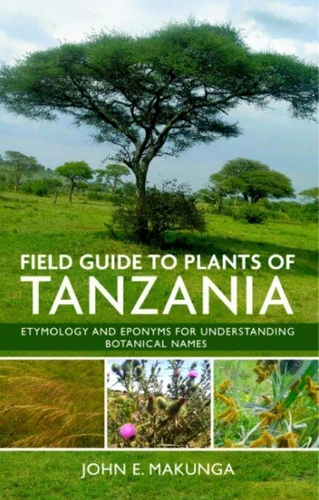Field Guide to Plants of Tanzania: Etymology and Eponyms for Understanding Botanical Names
Par :Formats :
Disponible dans votre compte client Decitre ou Furet du Nord dès validation de votre commande. Le format ePub est :
- Compatible avec une lecture sur My Vivlio (smartphone, tablette, ordinateur)
- Compatible avec une lecture sur liseuses Vivlio
- Pour les liseuses autres que Vivlio, vous devez utiliser le logiciel Adobe Digital Edition. Non compatible avec la lecture sur les liseuses Kindle, Remarkable et Sony
 , qui est-ce ?
, qui est-ce ?Notre partenaire de plateforme de lecture numérique où vous retrouverez l'ensemble de vos ebooks gratuitement
Pour en savoir plus sur nos ebooks, consultez notre aide en ligne ici
- FormatePub
- ISBN8224129102
- EAN9798224129102
- Date de parution20/03/2024
- Protection num.pas de protection
- Infos supplémentairesepub
- ÉditeurVirtued Press
Résumé
This fully revised second edition of the plant field guidebook, was written in Tanzania by an experienced author in the field of conservation. The book is well researched and prepared to suit the demand of lecturers, students, researchers, conservationists, tour guides, tourists, horticulturalists, environmental Impact assessment (EIA) experts and natural resources consultants among others. The guidebook contains plants of different growth forms, both aquatic and terrestrial ecosystems, and therefore, it provides a good platform for considerate, understanding and conserving Tanzania's flora and hence, its sustainable utilization.
Up to 387 plant species from 81 families have been identified and represented by coloured photographs, also furnished by glossaries of botanical terms, illustrations of leaf types, shapes, phyllotaxy, types of inflorescence and fruits. Some of the plants included in this field guidebook are rare, endemic, threatened and invasive lien species. Knowing these species, therefore, helps in augmenting management efforts to conservation authorities, individual users and other stakeholders.
Etymology and eponyms are the key concepts intended to help readers in understand in a simple, fascinating and instructive way, plants' scientific names presented in this field guidebook, which basically have their roots from the Latin and Greek languages. The guidebook is well organized with valuable contents, which surely enlightens readers' understanding in plant science. The author of this field guidebook is an experienced lecturer, researcher and consultant in a variety of fields, in particular, disaster risk management, environment, climate change and nature conservation.
Up to 387 plant species from 81 families have been identified and represented by coloured photographs, also furnished by glossaries of botanical terms, illustrations of leaf types, shapes, phyllotaxy, types of inflorescence and fruits. Some of the plants included in this field guidebook are rare, endemic, threatened and invasive lien species. Knowing these species, therefore, helps in augmenting management efforts to conservation authorities, individual users and other stakeholders.
Etymology and eponyms are the key concepts intended to help readers in understand in a simple, fascinating and instructive way, plants' scientific names presented in this field guidebook, which basically have their roots from the Latin and Greek languages. The guidebook is well organized with valuable contents, which surely enlightens readers' understanding in plant science. The author of this field guidebook is an experienced lecturer, researcher and consultant in a variety of fields, in particular, disaster risk management, environment, climate change and nature conservation.
This fully revised second edition of the plant field guidebook, was written in Tanzania by an experienced author in the field of conservation. The book is well researched and prepared to suit the demand of lecturers, students, researchers, conservationists, tour guides, tourists, horticulturalists, environmental Impact assessment (EIA) experts and natural resources consultants among others. The guidebook contains plants of different growth forms, both aquatic and terrestrial ecosystems, and therefore, it provides a good platform for considerate, understanding and conserving Tanzania's flora and hence, its sustainable utilization.
Up to 387 plant species from 81 families have been identified and represented by coloured photographs, also furnished by glossaries of botanical terms, illustrations of leaf types, shapes, phyllotaxy, types of inflorescence and fruits. Some of the plants included in this field guidebook are rare, endemic, threatened and invasive lien species. Knowing these species, therefore, helps in augmenting management efforts to conservation authorities, individual users and other stakeholders.
Etymology and eponyms are the key concepts intended to help readers in understand in a simple, fascinating and instructive way, plants' scientific names presented in this field guidebook, which basically have their roots from the Latin and Greek languages. The guidebook is well organized with valuable contents, which surely enlightens readers' understanding in plant science. The author of this field guidebook is an experienced lecturer, researcher and consultant in a variety of fields, in particular, disaster risk management, environment, climate change and nature conservation.
Up to 387 plant species from 81 families have been identified and represented by coloured photographs, also furnished by glossaries of botanical terms, illustrations of leaf types, shapes, phyllotaxy, types of inflorescence and fruits. Some of the plants included in this field guidebook are rare, endemic, threatened and invasive lien species. Knowing these species, therefore, helps in augmenting management efforts to conservation authorities, individual users and other stakeholders.
Etymology and eponyms are the key concepts intended to help readers in understand in a simple, fascinating and instructive way, plants' scientific names presented in this field guidebook, which basically have their roots from the Latin and Greek languages. The guidebook is well organized with valuable contents, which surely enlightens readers' understanding in plant science. The author of this field guidebook is an experienced lecturer, researcher and consultant in a variety of fields, in particular, disaster risk management, environment, climate change and nature conservation.



